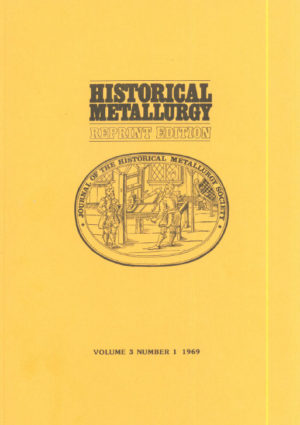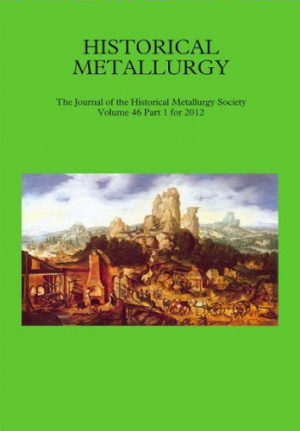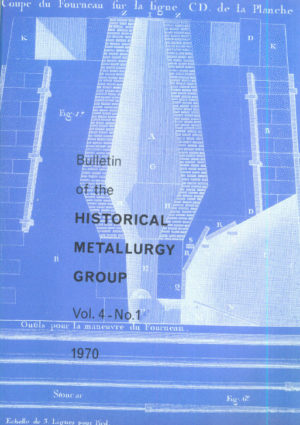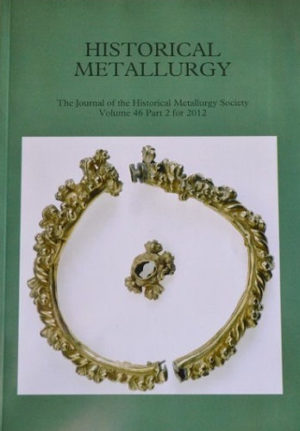Journal Contents
Metallurgical investigations of cast irons from Les Forges du Saint-Maurice Ironworks, Quebec, Canada
Henry Unglik
Pages 1-7
This is an account of the metallurgical investigation carried out on twelve cast irons from les Forges du Saint-Maurice, Canada’s first ironworks. The macrostnicture, microstructure, hardness and chemical analysis of grey, mottled and white irons are presented together with a short history of the site. The results were used to characterize the material, its composition, structure, foundry and mechanical properties. The method of manufacture of the cast irons and the technological development of the ironworks is considered.
Terrestrial and meteoritic nickel in the Indonesian Kris
Bennet Bronson
Pages 8-15
Pamor, the etch-resistant metal traditionally used in the blades of Southeast Asian krises, appears to have been originally a smelted iron-nickel alloy. Small amounts of a meteoritic alloy were later used by kris makers, mainly in the 1840s-1860s. Modem alloys and pure nickel have also been used since about 1900. But most pamor came from the Indonesian island of Sulawesi, where there are large deposits of iron-nickel ores of a type that could be smelted in simple furnaces. The evidence, though incomplete, points to this as a probable case of the regular production of an iron-nickel alloy, on a modest but commercial scale, many decades and perhaps centuries before such alloys began to be made by Western steelmakers. It is one of the few such cases known.
Denis Hayford: An early steel master
C Barraclough. and B G Awty
Pages 16-17
Considering his importance in the steel industry, Denis (Dan) Hayford (Heyford) has remained a somewhat shadowy figure. He is known to have been connected with ironmaking operations in South Yorkshire and North Derbyshire and also in Cheshire and in Northumberland from the 1670s onwards. By 1693 he was supplying steel to the Lancashire market. By the same date he was operating the so-called Duke of Norfolk’s Ironworks, in partnership with John Fell and the account books have survived as the ‘Staveley Ironworks Records’. These also include ledger accounts of a ‘Steel Trade’ in which John Fell and Denis Hayford were the sole partners from 1699 to 1724; significantly one of the very first entries is the supply of ‘steel for the Northern Trade’. From a small beginning, by the time Hayford died in 1727, this ‘steel trade’ was supplying some 60 to 70 tons of blister steel per annum.’ After Hayford’s death, his son, Millington Hayford, retained a three-eighths share in the steel operations, his widow selling out in 1744.
British firebricks in North America
Karl Gurcke with, notes by Arthur Dunn
Pages 18-24
When the cities of the Pacific Northwest were founded the local firebrick industry was rather late in developing because of the lack of deposits of good, or even adequate, fireclays. This coupled with the extremely low priced imported products restricted possible competition from local sources.
The primary source for the region’s firebrick was from the main exporting country. Great Britain, and this trade continued to exist from about the 1850s unto the beginning of World War I . By that time, and assisted by the fact that transport was simply not available, the local industry had established itself It is fortunate for those who are interested in industrial archaeology, and the history of technology, that not only the British, but also the local companies clearly branded their own bricks.
An examination of Roman iron working residues from Loughor, West Glamorgan, Wales
A P Greenough
Pages 25-27
Slagged material found dispersed through the earth which had slumped from a Roman rampart at the site of the fort at Loughor was identified as the residue from a forge used for welding iron though the hypothesis that it derived from a bloomery cannot be entirely rejected. Fragments of wood as well as charcoal were embedded in some of the specimens examined.
Microstructures of puddling slags from Fontley, England and Roxbury, Connecticut, USA
David Killick and Robert B Gordon
Pages 28-36
Samples of slags from the site of Henry’s Cort’s original iron puddling furnace at Fontley Forge, Hampshire, and a puddled steel works at Roxbury, Connecticut, have very similar compositions that are in agreement with what is known of the operation of puddling furnaces. Fayalite is the dominant constituent and is accompanied by varying proportions of magnetite, silica in the form of tridymite or cristobalite, iron sulphide, and a groundmass composed of complex intergrowths of magnetite, fayalite and glass. Wustite and metallic iron are absent and the content of Na20, KjO, CaO, and A I 2 O 3 is very low. These characteristics distinguish the slags studied from bloomery and finery slags and, if found in other examples, may be diagnostic of puddling slag.
In the three principal methods of making wrought iron – bloom smelting, fining, and puddling – solid iron is formed in a liquid slag that approximates the composition of fayalite (2FeO Si02). Chemical analyses of the bulk compositions of slags from the three processes overlap to such a degree that a given slag sample cannot be associated with the process it is from on the basis of composition alone.
Additional information about a slag can be obtained from its microstructure. Compilations of slag microstructures have been published by Sperl and byBachmantf while Kresten has presented a detailed study of the chemistry and mineralogy of ancient Swedish slags. Bloomery slags have received the most attention in recent research. Fells has described the structures of several English bloomery slags in detail and has also reviewed the results of previous research on slag structure. Micrographs of finery slags have been published by Bedwin and by Morton and Wingrove; inspection of their photographs shows that there are no differences in microstructure that could be used to distinguish finery from bloomery slag. No examples of the microstructure of puddling slags appear to have been published. We have examined the structures of samples of puddling slags from Fontley Forge (Hampshire, England) and Roxbury (Connecticut, United States) to see if their structures distinguish them from finery and
bloomery slags.
The change from charcoal to coke in iron smelting
J E Rehder
Pages 37-43
From the two bases of 19th century American experience with alternate blast furnace fuels and of modem knowledge of combustion, it is possible to construct with some confidence the changes that occurred when Abraham Darby in 1709 first operated an iron blast furnace on coke instead of charcoal as fuel. Production rate would have fallen by more than one third, nearly 80 percent more air would be required per ton of iron made, and the tapped iron would be at higher temperature, be more fluid, and would make machinable thin-sectioned gray iron castings. The need for more air proved to be a serious problem, which was solved finally by the use of steam power. The coke smelted iron made possible the castings that were essential for the construction of the new steam engines that were being developed, and there was a symbiosis that was productive but that took 40 to 50 years to mature. The new coke pig iron was not popular at the finery because the softer iron took longer to fine and had higher losses, but the correction for this was worked out and from the 1750s onward, charcoal furnaces were steadily and increasingly rapidly converted to coke fuel.
Wrought iron again: The Blists Hill Ironworks officially opened
Stuart B Smith and W K V Gale
Pages 44-61
The official opening of the Blists Hill Ironworks by HRH The Prince of Wales on Friday March 6th 1987 marked the culmination of the first phase of the development of the Ironbridge Gorge Museum, When it was conceived twenty years ago, the Museum set itself six major objectives: to restore the Iron Bridge, establish the Coalport china Museum, conserve Abraham Darby’s Furnace at Coalbrookdale, build a Museum of Iron, excavate the Bedlam Furnaces and to create a living museum at Blists Hall which would include a working Wrought Ironworks.
![[Test] The Historical Metallurgy Society](https://test.historicalmetallurgy.org/wp-content/uploads/2020/02/Logo120.png)





There are no reviews yet.